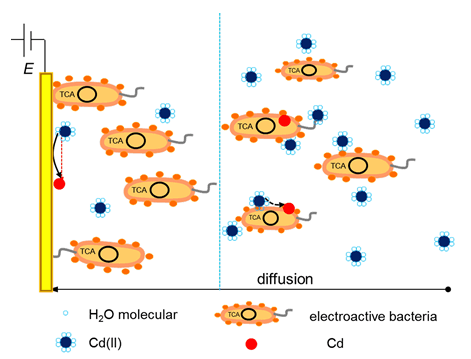摘要/Abstract

使用循环伏安法和电位阶跃法研究了希瓦氏菌MR-1野生株及其突变株△omcA-△mtrc对玻碳电极表面电沉积Cd的影响.发现加入希瓦氏菌野生株后:(1) Cd在玻碳电极表面的电沉积峰电位明显负移;(2)当扫描速率较低(20 mV·s-1)且进入第二圈扫描时,Cd的电沉积过程分两步Cd (Ⅱ)-Cd (I)-Cd进行;(3)通过电位阶跃实验得出Cd (Ⅱ)扩散到玻碳电极表面的速率变得缓慢;(4) Cd在玻碳电极表面的电沉积过程由连续三维成核转变成瞬时三维成核过程;加入突变株后,Cd (Ⅱ)扩散到玻碳电极表面的速率更加缓慢,它的电沉积过程为瞬时三维成核过程.扫描电子显微镜的结果也正好证实了该影响机制.
关键词: 希瓦氏菌MR-1, 电沉积, Cd, 成核机理
The geochemical cycle of heavy metal ion driven by microbes is widespread in nature. Previous studies are focused on the removal efficiency in the treatment of Cd in the bioelectrochemical systems; however, little is reported regarding the reduction mechanism of Cd on the electrode surface in the neutral physiological environment. In this work, we investigated the microbiological influence of Shewanella oneidensis MR-1 wild type and its mutant △omcA-△mtrc for Cd electrodeposition on a glassy carbon electrode (GCE) surface by using cyclic voltammetric (CV) and chronoamperometric methods. The CVs and I-t curves were carried out in a three-electrode system in the present of MR-1 cells (the value of optical density at 600 nm was 0.5) under nitrogen atmosphere. Much results were found in the present of MR-1 wild type:(1) the reducing peak potentials for Cd electrodeposition obviously negative shifted from CVs; (2) when the scan rate was comparatively slow (20 mV·s-1 vs. saturated calomel electrode), the Cd electrodeposition process contained two steps in the second scan in CVs which were Cd(Ⅱ)-Cd(I)-Cd; (3) the average diffusion coefficient of Cd(Ⅱ) from bulk solution to GCE surface (0.93×10-6 cm·s-1), calculated from I-t curves, was slightly slower than that without MR-1 wild type (1.1×10-6 cm·s-1); (4) the progressive nucleation mechanism for Cd electrodeposition changed into an instantaneous three-dimensional nucleation by compared with their actual nucleation curves. Once the Cd electrodeposition process was performed in the solution with △omcA-△mtrc mutant, the diffusion of Cd(Ⅱ) from bulk solution to GCE surface (the average diffusion coefficient was 0.84×10-6 cm·s-1) changed much slower than before; nonetheless, the Cd electrodeposition was also consistent with the instantaneous three-dimensional nucleation. On the other hand, inhomogeneous Cd particles were observed on GCE surfaces at different stepping potentials from scanning electron microscopy (SEM) images. In contrast, the homogeneous Cd particles were found in the present of MR-1 wild type and △omcA-△mtrc mutant when the reduction potentials were higher than -0.9 V. These SEM results regarding the surface morphology of electrodeposited Cd particles also well agreed with three-dimensional nucleation mechanisms.
Key words: Shewanella oneidensis MR-1, electrodeposition, Cd, nucleation mechanism
PDF全文下载地址:
点我下载PDF
